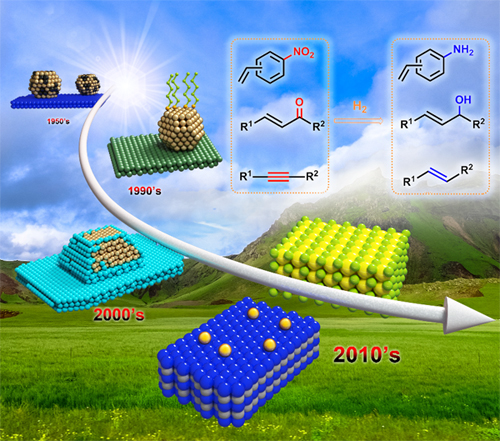The research group led by Profs. ZHANG Tao and WANG Aiqin reviewed the advances in selective hydrogenation reactions catalyzed by nano- and single-atom catalysts. The review was published in Chemical Reviews.
Selective hydrogenation refers to when two (or more) reducible functional groups co-exist in the reactants, the targeted one is saturated whereas the other remains intact. Selective hydrogenation reactions have wide applications in both petrochemical and fine chemical industries. However, it remains a great challenge because of the various side reactions (e.g., over-hydrogenation) on traditional nano-catalysts.

Chronological development of nano- and single atom catalysts for the selective hydrogenation reaction of alkynes, nitrostyrenes, and α,β-unsaturated aldehydes/ketones. (Image by ZHANG Leilei)
Experimental and theoretical calculation results revealed that when the ensemble of active metal is reduced, the adsorption of the untargeted group is weakened, by which the chemoselectivity can be greatly improved. Accordingly, the “active site isolation” strategy is proposed to achieve high selectivity in hydrogenation reactions.
This review summarized the approaches towards the site isolation, including adsorption/grafting of N/S/P-containing organic molecules on the metal surface, partial covering of active metal surface by metal oxides either via doping or through strong metal-support interaction, confinement of active metal nanoparticles in micro- or meso-pores of the supports, and construction of single-atom catalysts on reducible oxides or inert metals.
Both advantages and disadvantages of each approach have been discussed for three types of chemoselective hydrogenation reactions, including alkynes/dienes to monoenes, α,β-unsaturated aldehydes/ketones to the unsaturated alcohols, and substituted nitroarenes to the corresponding anilines. Finally, the development directions in this area were prospected, and some advices were put forward.
This work was supported by the National Key Projects for Fundamental Research and Development of China, the National Natural Science Foundation of China, the Strategic Priority Research Program of the Chinese Academy of Sciences. It was dedicated to the 70th anniversary of DICP, CAS. (Text and image by ZHANG Leilei)